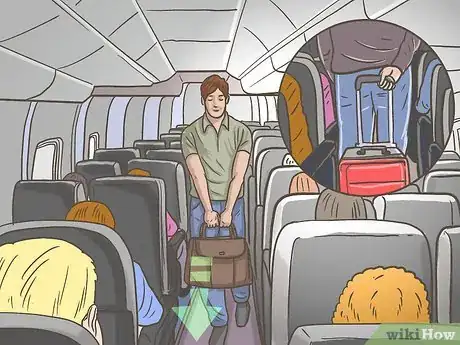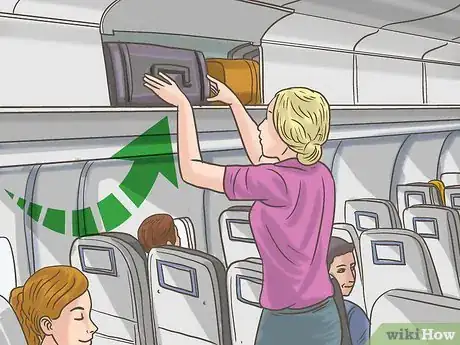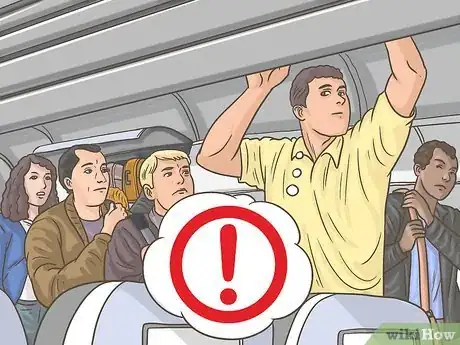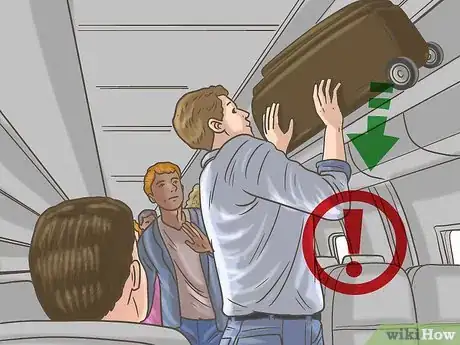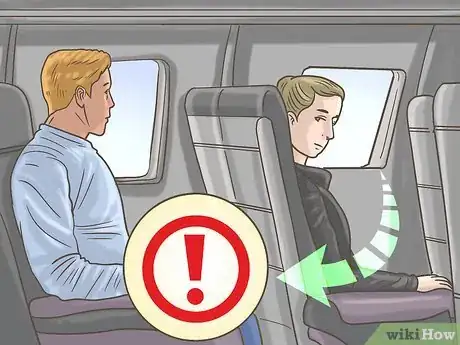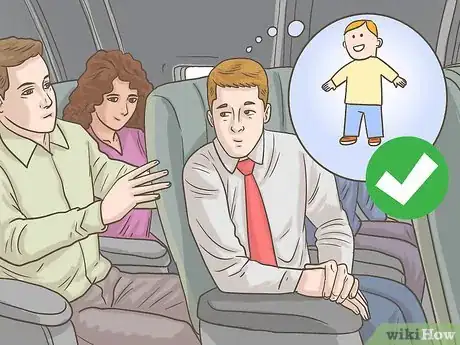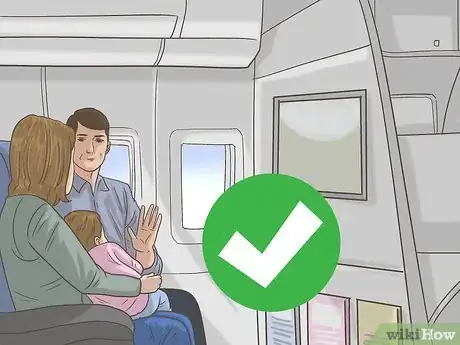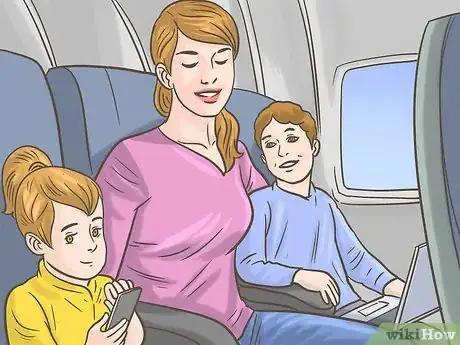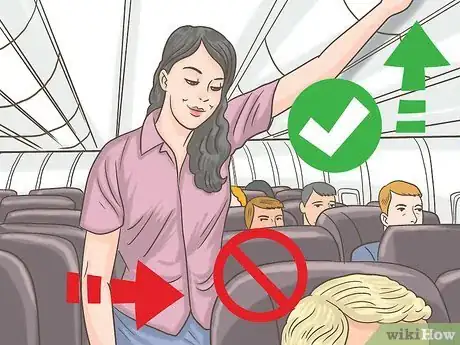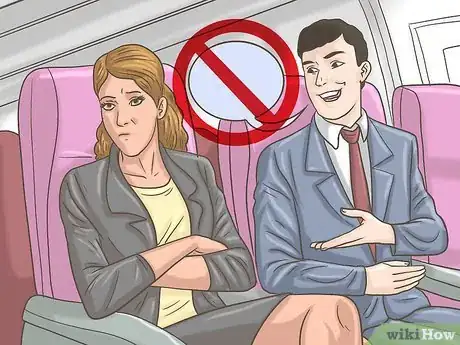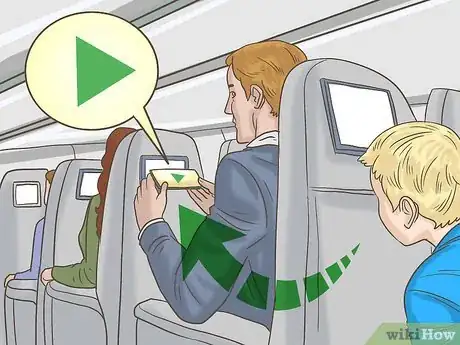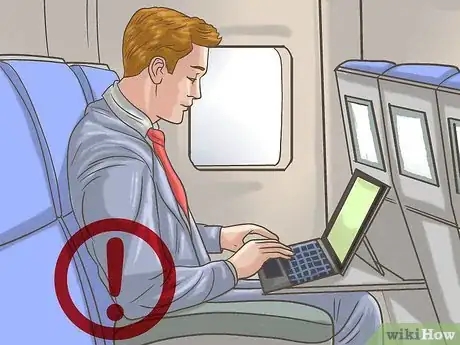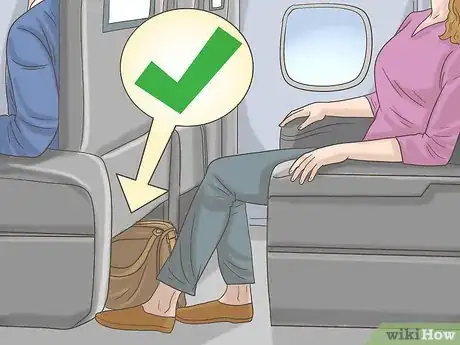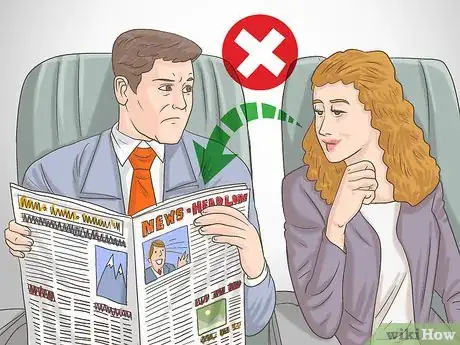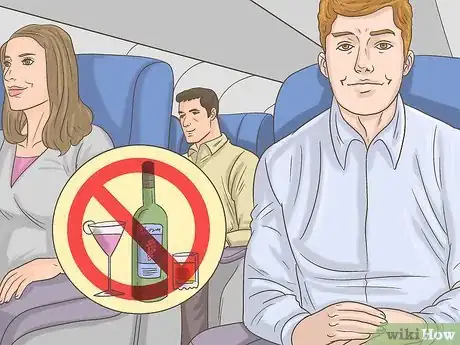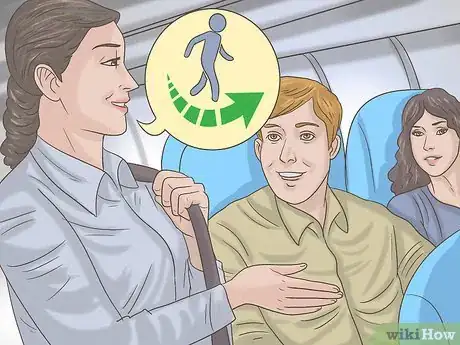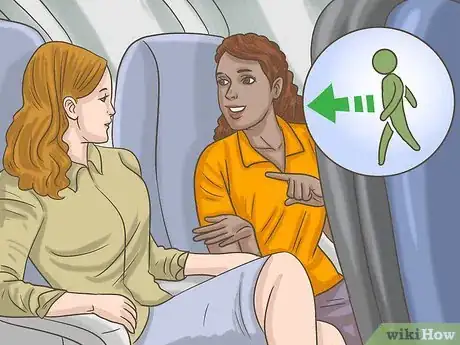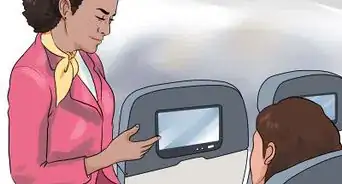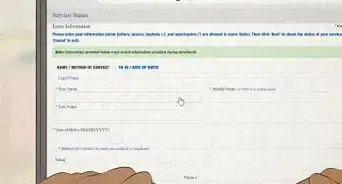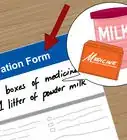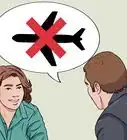This article was co-authored by Luba Lee, FNP-BC, MS. Luba Lee, FNP-BC is a Board-Certified Family Nurse Practitioner (FNP) and educator in Tennessee with over a decade of clinical experience. Luba has certifications in Pediatric Advanced Life Support (PALS), Emergency Medicine, Advanced Cardiac Life Support (ACLS), Team Building, and Critical Care Nursing. She received her Master of Science in Nursing (MSN) from the University of Tennessee in 2006.
wikiHow marks an article as reader-approved once it receives enough positive feedback. In this case, 92% of readers who voted found the article helpful, earning it our reader-approved status.
This article has been viewed 246,746 times.
When traveling by air, you're sometimes forced to rub elbows (literally) with people you don't know. In close quarters and for extended periods, a little consideration can go a long way. To make a flight as smooth as possible for both yourself and others (and to avoid dirty looks) practice airplane etiquette as follows.
Steps
Storing Your Belongings
-
1Carry your bag in front of you and low to the ground as you walk down the aisle in search of your seat. Holding it up and at your sides will inevitably knock seated passengers on their arms, shoulders, and heads. You can pull it along if it has wheels.
-
2Utilize the overhead space above your seat row. Do not place your bags overhead at the front of the plane unless you are sitting in that row. Don't put your bag in a bin near the front of the plane for a quick exit -- it means someone else will have to wait until the entire plane has emptied to walk back to get their bag. Taking the storage space of other passengers is rude and can delay departure as they search for storage.Advertisement
-
3Avoid hogging the aisle. Remember that space is limited on board. Always be swift and alert while putting things in the overhead lockers, as other people need aisle space to get around you and to their seats. Place the items that you will frequently use in your seat back pocket or under the seat in front of you.
-
4Take care when retrieving luggage from the overhead compartment! It may be positioned to fall on you or someone else. If you have a lot of bulky, heavy luggage in the overhead bin, wait until others have left before standing and blocking other people from leaving the plane (they may have another flight to get to), or ask somebody to help you get your luggage down while everybody is waiting to leave the plane. This will help with traffic flow and allows all passengers to leave the plane as fast as possible.
Sitting with Respect
-
1Keep your chair upright at least until you're told it can be reclined. Don't lean your chair back as soon as you get on. If you do decide to recline your chair when you can, do it slowly. Otherwise, you risk bumping the head of the unsuspecting passenger behind you who's getting something from the bag at their feet, or you could knock over the drink on their tray. Remember to return the seat to the upright position during the meal and drink servings, or if possible, wait until food and beverages are finished being served and cleaned up.
-
2Check behind you—is that person tall, or do they have a child on their lap? If so, consider keeping your seat upright out of consideration, especially if it's a short flight. By reclining, you're taking space away from the passenger behind you; you may be more comfortable but at someone else's expense. You can also ask them if reclining your seat would be all right. If you're someone who can't make yourself comfortable without reclining, then do your best to choose an aisle, bulkhead, or exit row seat when booking the flight so the person behind you has extra space.
-
3Choose a bulkhead or exit row seat if you're a tall/big person or have a child on your lap and know that having the seat in front of you reclined will make you uncomfortable, (unless you have a child, in which case you should never choose an exit row seat). Not only will you have more space, but the person in front of you will also have more space and may decide not to recline their seat out of consideration for you. If you sit in the middle, however, the person in front of you is cramped, as well, and will probably want to recline their seat, whether you like it or not.
-
4Keep an eye on any children you're traveling with. Children tend to bump, kick, or yank the seat in front of them without realizing it throughout the flight, which can make the person in front of them very uncomfortable. It's difficult enough to control some children on a long flight, but it's even more difficult to deal with an angry passenger in front of you.
- If your child/ren has/ve difficulty flying, do everything you can to relax the child/ren so you do not disturb other passengers nearby. Bring plenty of books, games, snacks, and other things to keep your child/ren quietly occupied.
- You can also try walking to the galley area of the plane to stretch your child's legs.
- Change diapers in the restroom on the plane. In most restrooms, there are changing tables and trash bins for diaper disposal.
- When breastfeeding, use a drape, both for your privacy and for the comfort of the other passengers.
-
5Avoid getting involved further if a passenger breaches etiquette by doing something like constantly thumping or yanking your seat back, and refusing your polite request not to do so. Instead, ask a flight attendant to handle the situation, and if they can't or even won't (this does happen), ask politely but insistently for the chief flight attendant (purser) to handle it.
-
6Avoid grabbing the back of the seat in front of you. Grabbing the seat back as you walk in the aisle or your row can be unpleasantly jarring to the person sitting in it. Copy the flight attendants who balance themselves in the aisle by grabbing the luggage compartments above their heads, rather than the seat backs.
Respecting Personal Space
-
1Respect others' willingness to talk. No matter how much you love to make new friends on the plane, the person next to you might rather get some work done, or simply may not feel like being chatty. If a friendly comment gets a minimal answer, take the hint and leave them be. If you're traveling with children, try to avoid letting them think of passengers as playmates. Some passengers will smile to be polite, but may not be interested in playing "peek a boo" with the child.
-
2Keep in mind your screen is visible to those behind you if you want to watch a movie on your DVD player. If your movie has nudity, graphic violence, etc. it may offend the more sensitive viewers (e.g. children) looking on. Using a smaller, handheld device to view movies, such as an iPod Touch, may be more practical in this situation.
-
3Watch your elbows. If you're reading a newspaper or using a laptop, try not to let your elbows "spill over" onto someone else's personal space. Do your best not to hog the armrests, especially if the person next to you is in the middle and has limited space, to begin with.
- Use your armrest and head/earphone plug outlet. Don't use someone else's because it's more convenient for you.
-
4Keep your stuff close. If you put a bag or a jacket at your feet, don't let it spill over onto the legs or feet of the person sitting next to you.
-
5Get your reading material—don't read theirs. They'll notice, and it's nosy and rude.
- If you're stuck in an aisle seat but still want to enjoy the view, don't lean over the person next to you to look out the window.
-
6Pack headphones or earphones for any portable electronics, especially games and DVD players. Hearing someone else's music and sounds can be very irritating.
-
7Avoid getting drunk during (or before) the flight. You may be having the time of your life, but your fellow passengers may not think so (some airlines don't allow any passengers on board suspected of being over the limit on alcohol consumption).
-
8Do not start or join phone calls or group meetings. This includes voice-over-IP services like Skype and group call services like Discord. Phone conversations, especially on Wi-Fi, can be a nuisance to other passengers; as such, many airlines and the FCC do not support the use of airplane Wi-Fi for phone calls. Keep those for a while you are on the ground in your hotel room.
Moving With Care
-
1Be considerate of other passengers when you exit the plane. Resist the urge to push your way out first; let those nearest to the exit disembark the plane first. When your turn comes, move quickly so people with connecting flights can make it in time.
-
2Think ahead and book your flight early if you know you'll need a connecting flight. This way, you can get a seat up front and exit quickly.
-
3Get up to use the lavatory or walk around only when necessary. Go through your carry-on luggage at intervals. If you need something, think ahead and retrieve items you might need later on during the flight.
-
4Avoid yanking on the seat in front of you for support when you get up; use the seat armrests. If you want to get up but there are one or more passengers between you and the aisle, politely request that they get up to let you pass. Don't try to clamber over them; apart from the discomfort this will inevitably cause, you might injure yourself/them if you lose your balance and fall.
Expert Q&A
-
QuestionWhat if I'm sitting near a toddler that's coughing?
 Luba Lee, FNP-BC, MSLuba Lee, FNP-BC is a Board-Certified Family Nurse Practitioner (FNP) and educator in Tennessee with over a decade of clinical experience. Luba has certifications in Pediatric Advanced Life Support (PALS), Emergency Medicine, Advanced Cardiac Life Support (ACLS), Team Building, and Critical Care Nursing. She received her Master of Science in Nursing (MSN) from the University of Tennessee in 2006.
Luba Lee, FNP-BC, MSLuba Lee, FNP-BC is a Board-Certified Family Nurse Practitioner (FNP) and educator in Tennessee with over a decade of clinical experience. Luba has certifications in Pediatric Advanced Life Support (PALS), Emergency Medicine, Advanced Cardiac Life Support (ACLS), Team Building, and Critical Care Nursing. She received her Master of Science in Nursing (MSN) from the University of Tennessee in 2006.
Board-Certified Family Nurse Practitioner Kindly ask one of the flight attendants if they can possibly reassign you to a different seat.
Kindly ask one of the flight attendants if they can possibly reassign you to a different seat. -
QuestionWhat if I'm sitting behind a lady that is coughing?
 Luba Lee, FNP-BC, MSLuba Lee, FNP-BC is a Board-Certified Family Nurse Practitioner (FNP) and educator in Tennessee with over a decade of clinical experience. Luba has certifications in Pediatric Advanced Life Support (PALS), Emergency Medicine, Advanced Cardiac Life Support (ACLS), Team Building, and Critical Care Nursing. She received her Master of Science in Nursing (MSN) from the University of Tennessee in 2006.
Luba Lee, FNP-BC, MSLuba Lee, FNP-BC is a Board-Certified Family Nurse Practitioner (FNP) and educator in Tennessee with over a decade of clinical experience. Luba has certifications in Pediatric Advanced Life Support (PALS), Emergency Medicine, Advanced Cardiac Life Support (ACLS), Team Building, and Critical Care Nursing. She received her Master of Science in Nursing (MSN) from the University of Tennessee in 2006.
Board-Certified Family Nurse Practitioner If possible, ask to be seated in a different seat. If that is not possible, wear a mask if you have one. If you don’t have a mask, you improvise with a scarf. Once you arrive at your destination take a shower, blow your nose, gargle your throat, and change your clothes. You may want to take extra vitamin C, D, and zinc to support your immune system.
If possible, ask to be seated in a different seat. If that is not possible, wear a mask if you have one. If you don’t have a mask, you improvise with a scarf. Once you arrive at your destination take a shower, blow your nose, gargle your throat, and change your clothes. You may want to take extra vitamin C, D, and zinc to support your immune system. -
QuestionWhat volume of music is allowed during the flight?
 Community AnswerYou can have your headphones on at any sound level, but playing music from a device at any sound level would not be respectful to other passengers and may not be allowed on some flights.
Community AnswerYou can have your headphones on at any sound level, but playing music from a device at any sound level would not be respectful to other passengers and may not be allowed on some flights.
Warnings
- Remember that even if you wear headphones while you listen to loud music, your direct neighbor can hear it, and will likely be less than pleased about it. Turn your music player to a more moderate level for the flight.⧼thumbs_response⧽
- Do not pack strong-smelling foods (e.g. tuna sandwiches, anything with onions, deli, etc.) to eat on the plane. Your fellow passengers may be sensitive to the smell.⧼thumbs_response⧽
